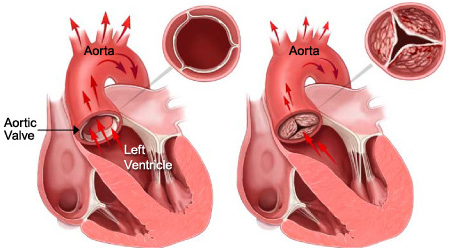Aortic Valve Stenosis Causes, Symptoms, Diagnosis and Treatment

What Is Aortic Valve Stenosis?
Aortic stenosis (AS) is the narrowing of the exit of the left ventricle of the heart such that problems result.
It may occur at the aortic valve as well as above and below this level. It typically gets worse over time.
When the aortic valve is obstructed, the heart needs to work harder to pump blood to the body. Eventually, this extra work limits the amount of blood it can pump and may weaken the heart muscle.
In those who have symptoms, without repair, the chance of death at five years is about 50% and at 10 years is about 90%.
Causes Of Aortic Valve Stenosis:
Causes of aortic valve stenosis include:
- Congenital heart defect.
Some children are born with an aortic valve that has only one (unicuspid), two (bicuspid) or four (quadricuspid) leaflets — not three.
This deformity may not cause any problems until adulthood, at which time the valve may begin to narrow or leak and may need to be repaired or replaced. - Calcium buildup on the valve.
With age, heart valves may accumulate deposits of calcium (aortic valve calcification).
As blood repeatedly flows over the aortic valve, deposits of calcium can accumulate on the valve’s leaflets. - Rheumatic fever.
A complication of strep throat infection, rheumatic fever may result in scar tissue forming on the aortic valve. Scar tissue alone can narrow the aortic valve and lead to aortic valve stenosis.
Risk Factors Of Aortic Valve Stenosis:
- A deformed aortic valve
- Age.
Aortic valve stenosis may be related to increasing age and the buildup of calcium deposits on heart valves. - Chronic kidney disease.
Symptoms Of Aortic Valve Stenosis:
Signs and symptoms include:
- Chest discomfort: The chest pain may get worse with activity and reach into the arm, neck, or jaw. The chest may also feel tight or squeezed.
- Cough, possibly bloody
- Breathing problems when exercising
- Becoming easily tired
- Feeling the heart beat (palpitations)
- Fainting, weakness, or dizziness with activity
- Becoming easily tired with exertion (in mild cases)
- Failure to gain weight
- Poor feeding
- Serious breathing problems that develop within days or weeks of birth (in severe cases)
Diagnosis Of Aortic Valve Stenosis:
The following diagnostic tests help confirm aortic valve stenosis:
- Echocardiogram.
- Electrocardiogram (ECG).
- Chest X-ray.
- Cardiac catheterization.
- Exercise tests.
- Computerized tomography (CT) scan
- Magnetic resonance imaging (MRI).
Treatment Of Aortic Valve Stenosis:
The following treatment options are available:
- Medications, to relieve symptoms
- Balloon valvuloplasty
- Aortic valve replacement
- Transcatheter aortic valve replacement (TAVR)
- Surgical valvuloplasty
By : Natural Health News




